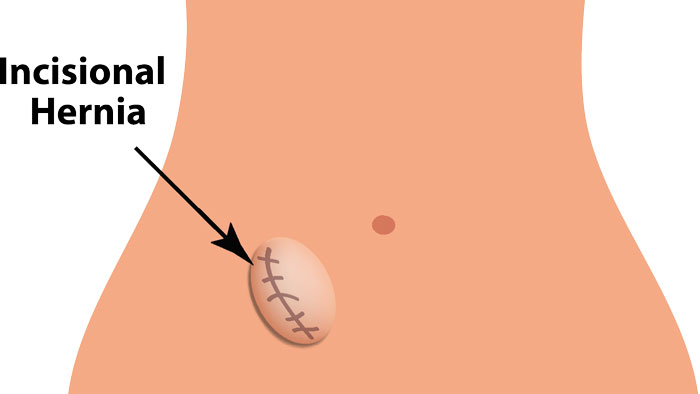A ventral hernia is a condition characterized by the protrusion of abdominal organs or tissue through a weakened area in the abdominal wall. This type of hernia occurs in the anterior abdominal wall, hence the term "ventral."

An incisional hernia is a condition where tissue protrudes through a surgical incision made in the abdominal wall, resulting in a noticeable bulge or lump. This type of hernia typically occurs as a complication following abdominal surgery, although it can also develop after other types of surgical procedures.
When a surgeon makes an incision in the abdominal wall to access internal organs or tissues during surgery, the natural integrity of the abdominal muscles and connective tissue is disrupted. In some cases, this weakened area of the abdominal wall may not fully heal or may become weakened over time, leading to the development of an incisional hernia.
Several factors can contribute to the development of an incisional hernia, including:
1. Surgical technique:
The manner in which the initial incision is made and closed during surgery can impact the risk of developing a hernia. Inadequate closure of the incision or excessive tension on the tissues during closure can increase the risk of herniation.
2. Patient factors:
Certain patient characteristics, such as obesity, advanced age, and underlying medical conditions like diabetes or connective tissue disorders, can increase the likelihood of developing an incisional hernia.
3. Wound healing:
Poor wound healing or complications such as infection at the surgical site can impair the body's ability to repair the abdominal wall, increasing the risk of herniation.
4. Physical activity:
Activities that place strain on the abdominal muscles, such as heavy lifting or straining during bowel movements, can increase the pressure within the abdomen and contribute to the development of a hernia.
The symptoms of an incisional hernia can vary depending on the size and location of the hernia, as well as individual factors such as pain tolerance. Common symptoms may include:
- A visible bulge or lump at the site of the surgical incision
- Discomfort or pain, particularly when coughing, lifting, or straining
- Nausea or vomiting, which may occur if the hernia becomes incarcerated or strangulated (i.e., the protruding tissue becomes trapped and blood supply is compromised)
- Changes in bowel habits, such as constipation or difficulty passing stools, if the hernia is large enough to affect intestinal function
In some cases, an incisional hernia may be asymptomatic and only detected during a routine physical examination or imaging studies performed for other reasons.
Diagnosis of an incisional hernia typically involves a combination of physical examination, medical history review, and imaging studies such as ultrasound, CT scan, or MRI. These tests can help determine the size, location, and severity of the hernia, as well as identify any associated complications.
Treatment options for incisional hernias vary depending on the size, symptoms, and overall health of the patient. In some cases, conservative management strategies such as watchful waiting, lifestyle modifications (e.g., avoiding heavy lifting), and supportive garments (e.g., abdominal binders) may be recommended to manage mild or asymptomatic hernias.
However, surgical repair is often necessary to effectively treat symptomatic or large incisional hernias and reduce the risk of complications. Surgical techniques for hernia repair may include traditional open surgery or minimally invasive approaches such as laparoscopic surgery or robotic-assisted surgery.
During hernia repair surgery, the protruding tissue is repositioned back into the abdominal cavity, and the weakened area of the abdominal wall is strengthened and reinforced with sutures or a synthetic mesh. The choice of surgical technique and mesh type depends on various factors, including the size and location of the hernia, the patient's overall health, and the surgeon's expertise.
Recovery from incisional hernia repair surgery can vary depending on the surgical approach, the extent of the repair, and individual factors such as age and overall health. Most patients can expect to return to normal activities within a few weeks following surgery, although it may take several months for full recovery.
As with any surgical procedure, incisional hernia repair carries certain risks and potential complications, including infection, bleeding, recurrence of the hernia, and damage to surrounding structures such as nerves or blood vessels. It's important for patients to discuss the potential risks and benefits of surgery with their healthcare provider and to follow postoperative instructions carefully to minimize the risk of complications.
In conclusion, an incisional hernia is a common complication of abdominal surgery characterized by the protrusion of tissue through a surgical incision in the abdominal wall. While small hernias may be asymptomatic and require no treatment, symptomatic or large hernias often require surgical repair to alleviate symptoms and reduce the risk of complications. Early diagnosis and prompt management are essential for optimizing outcomes and preventing potential complications associated with incisional hernias.
